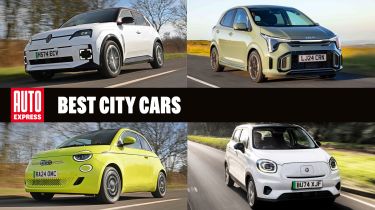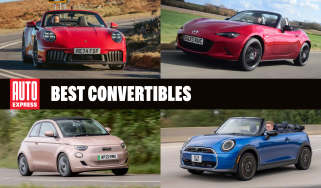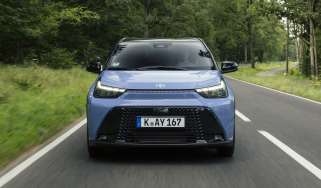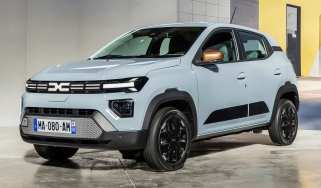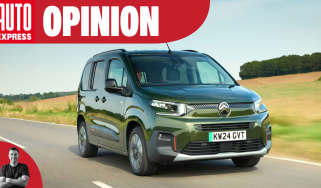Best city cars to buy 2025
Conquering the city streets? These are the best urban runabouts for the job
The best city cars have always offered manoeuvrability, value for money and low running costs, but now these compact cars also offer similar levels of tech and refinement to models that are much bigger in both size and price. However, while you’ll be paying a bit more than you used to, you’ll also be able to do a lot more with your brand-new city car.
Perhaps as a consequence of Britain’s love of SUVs, the city car market is a bit smaller than it once was. However, deciding the best of the remaining bunch can still prove a bit challenging. Not to worry, though, because we’ve done the hard work and picked out the top 10 examples to buy right now.
Our road-testing team has driven every city car on sale in the UK, and we’ve used our experts’ verdicts to determine the very best models in this sector of the market. Our road testers take all of the important factors into consideration when making their decisions, including price, practicality, safety and standard equipment, so you can be certain that you’re getting the very best city car for your money.
Compare the best city cars
| Best city cars to buy ranking | Name | Prices from | Max. WLTP combined range/MPG | Overall Auto Express star rating (out of 5) |
| 1 | Kia Picanto | £16,000 | 54.3mpg | 4 |
| 2 | Hyundai i10 | £16,500 | 55.3mpg | 4 |
| 3 | Leapmotor T03 | £16,000 | 165 miles | 4 |
| 4 | Renault 5 | £23,000 | 249 miles | 4.5 |
| 5 | Dacia Spring | £15,000 | 140 miles | 4.5 |
| 6 | MINI Cooper | £30.000 | 250 miles/47.9mpg | 4 |
| 7 | Suzuki Swift | £19,500 | 64.2mpg | 3.5 |
| 8 | Fiat 500e | £25,000 | 193 miles | 4 |
| 9 | Toyota Aygo X | £16,500 | 58.9mpg | 3.5 |
| 10 | Abarth 500e | £30,000 | 157 miles | 3.5 |
Scroll down for the mini-reviews on each of our top 10 best city cars
1. Kia Picanto
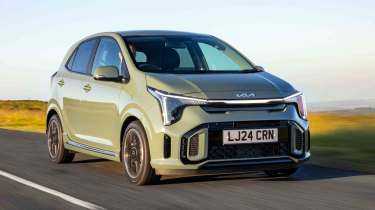
- Prices from £16,000
- Auto Express City Car of the Year 2025
Pros |
Cons |
|
|
The latest Kia Picanto is good to drive, has a big-car kit list, is spacious and well made, plus it offers a surprisingly grown-up driving experience.
The latest Picanto’s looks are inspired by the Kia EV9, but underneath you’ll find a familiar engine line-up which consists of a 62bhp 1.0-litre three-cylinder or a 1.2 four-cylinder unit that produces 77bhp. Neither of these engines are massive powerhouses, but they don’t need to be. The baby Kia’s small stature and excellent all-round visibility make it an absolute dream to drive around town, even for first-time drivers. Our road testers are also big fans of the Picanto’s quick steering and generally agile feel, which both make this a truly entertaining car to drive when you want to have a bit of fun.
Small engines mean equally small running costs, with every Picanto variant able to return over 50mpg with very little effort. Even those dreaded insurance premiums are kept well under control, with the whole line-up residing in groups three to seven.
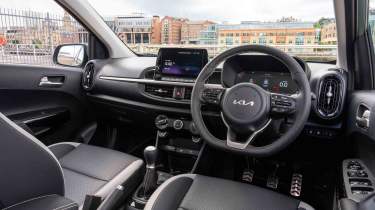
Step inside the Picanto and there’s a surprising amount of space to be found with enough room for four passengers to get reasonably comfortable. The 255-litre boot is also a perfectly decent size for a weekly shop.
The Picanto is a fiercely competitive package and a very likeable little car. It was a very worthy winner of our 2025 City Car of the Year title.
“It didn’t take long behind the wheel for us to be certain that there’s far more to appreciate than the funky, fresh robot look brought about by the new LED lights and updated face. This 3.6-metre bundle of enthusiasm shows us all just how nippy and easy city cars can be to drive.” - Alex Ingram, chief reviewer
2. Hyundai i10
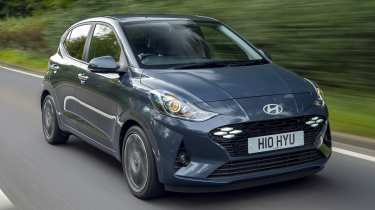
- Prices from £16,500
Pros |
Cons |
|
|
Our former City Car of the Year is still an excellent example of just how much this segment has evolved over the years.
The Hyundai i10 is a tiny car that’s as easy to drive and park as you’d reasonably expect, but it also manages to feel pleasingly refined on motorway runs. Although we feel that the closely related Kia Picanto is a little more entertaining, the i10 rules the roost if you want the sensation of driving a big-car but without the associated costs. We’d steer clear of the N-Line’s sportier suspension, though, as this spoils the otherwise smooth ride quality.
Stick towards the lower end of the i10- line-up and you’ll see insurance go as low as group 4, but no model really finds itself subject to ruinous premiums. Every variant also claims over 50mpg on paper, and we found the i10 to be slightly more efficient in the real-world when we compared it to the Toyota Aygo X in a group test.
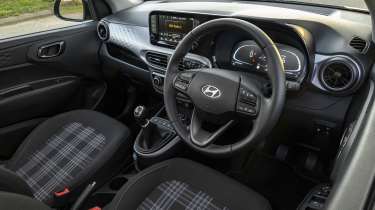
Hyundai has also done a respectable job of matching the i10’s grown-up feel with an equally sophisticated list of kit. This includes a digital instrument panel, mood lighting for the cabin and an array of active safety and assistance systems.
Just like its sister, the Picanto, the i10 can also fit four adults and their luggage without issue. You can stretch this number to five but, speaking from experience, we would only recommend this for occasional shorter journeys.
“The Hyundai i10 feels as mature and refined to drive as you’d think based on its understated, sensible appearance. The ride is smooth and considerably more comfortable than the Toyota Aygo X, plus the long fifth gear in the transmission and well-suppressed wind noise mean that it’s a more relaxed cruiser than the Toyota, too.” - Ellis Hyde, news reporter
3, Leapmotor T03
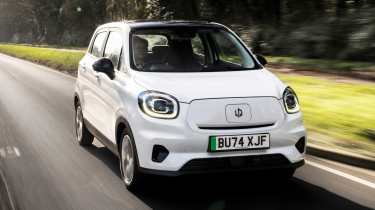
- Prices from £16,000
- Best for running costs
Pros |
Cons |
|
|
Leapmotor is one of the more recent arrivals on the UK’s shores, but it’s already making headlines with the little T03.
Starting from around £16,000, this is one of the cheapest electric cars on sale in the UK. During testing we managed to find a few slight flaws you’ll need to embrace or overlook if you wish to own a T03 — such as a bouncy ride and some overenthusiastic safety warning chimes — but overall there’s little to dislike if you simply want an affordable zero-emission car for zipping around the city streets.
The best news is that the T03’s low price doesn’t mean a laughably low battery range. The little Leapmotor can cover up to 165 miles on the WLTP combined cycle, and this should be more than enough for the majority of urban trips. When we pitted the Leapmotor against the similarly-priced Dacia Spring in a twin test, the T03 managed a real-world efficiency figure of 4.6 miles per kWh, which equates to around 166 miles of range, making this one of the few cars we’ve encountered where the real-world range was higher than that on paper, albeit ever-so slightly.

If you’re expecting a barebones features list, you may be pleasantly surprised. While the fancier touches are missing here (which is forgivable considering the price), the mod-cons such as a 10-inch touchscreen and air-conditioning are very much included.
“This might seem like a back-handed compliment, but the most important thing you can say about the way the Leapmotor T03 drives is that it feels like a normal car. From the outside, you might have a preconceived notion that it will flop around on its comically thin tyres and have all the balance of a mid-game Jenga tower, but overall, it is decent enough to drive.” - Richard Ingram, deputy editor
4. Renault 5
- Prices from £23,000
- Best for families
Pros |
Cons |
|
|
Some people accuse EVs of being a bit boring to look at, but the Renault 5 is a car that’ll easily put this argument to bed.
This retro-inspired supermini is one of the grooviest electric cars we’ve seen to date, and its price is equally appealing. Thankfully, Renault has kept things sensible when it comes down to how the 5 drives. We found the controls very light and easy to control, and the power delivery is delightfully smooth. The ride is a tad on the firm side, but this does mean you can have a bit of fun on the B-roads (although for maximum thrills you’ll want to look towards the Alpine A290 hot hatch version).
You’ll be able to take on plenty of those aforementioned B-roads, too, as the Renault 5 can also cover up to 248 miles on the official WLTP combined cycle. There are two batteries to choose from, a 40kWh or 52kWh unit, but even the smaller pack can cover a claimed 193 miles. When it faced the Fiat 500e in our twin test, the 40kWh Renault managed 164 miles between charges.
The cabin does a good job of maintaining the 5’s funky feeling, particularly in models fitted with part-yellow upholstery. In terms of tech, we think that Renault’s infotainment systems are currently some of the best in the business, and the 5 manages to put a number of pricier cars to shame in this regard.
“Up the pace, and the Renault 5 is quite entertaining to drive. The low centre of gravity provided by the battery pack in the floor limits body roll, but not so much that you can’t feel what the car is doing beneath you. Get bold through a corner, and you can even play with the 5’s balance on and off the throttle.” - Alex Ingram, chief reviewer
5. Dacia Spring
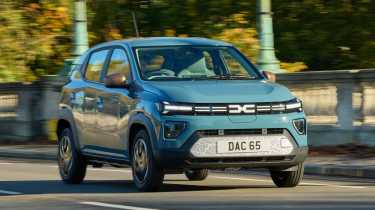
- Prices from £15,000
- Cheapest city car
Pros |
Cons |
|
|
It’s an inconvenient but true fact that plenty of EVs currently carry much higher starting prices than their combustion-powered alternatives, but the Dacia Spring is a huge exception to this rule. In fact, it’s currently the cheapest full-sized electric car that you can buy.
There are some obvious sacrifices that have been made in order to keep costs down — we found the cabin to be very noisy due to a lack of sound-deadening, and the standard-fit tyres don’t cope very well with more strenuous driving tasks — but those who prefer drama-free, lower-speed simplicity are well catered for. For pootling around city streets, the Spring is incredibly easy to drive, and it’ll neatly slot into plenty of tight spaces that many other modern cars will struggle with, too.
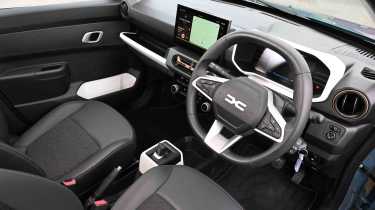
The Spring has a single battery option; a 26.8kWh unit which returns a maximum of 140 miles on the WLTP combined cycle. This means regular motorway journeys are probably out of the equation unless you don’t mind frequent recharging (a 20-80 per cent top-up takes 45 minutes at the maximum rate of 30kW). Stay within town, though, and a full charge should last a lot longer than you may think.
While Dacia’s penny-pinching means the Spring is quite humble when it comes to its appearance and features, there’s still a decent helping of modern essentials, including air-conditioning and cruise control.
“The main issue with the way that the Spring drives isn’t with the car itself, but the tyres Dacia fitted. When we first tested a Spring, it was fitted with Linglong tyres, and they’re short on grip – even for a car where performance very much takes a back seat.” - Alex Ingram, chief reviewer
6. MINI Cooper
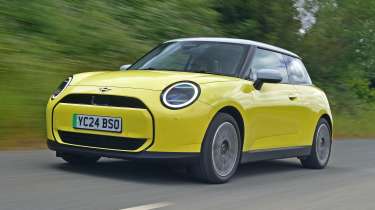
- Prices from £30,000
Pros |
Cons |
|
|
You could say that the original Mini was a city car pioneer, and the latest MINI Cooper continues this legacy of being a small, affordable and appealing model that’s also fun to drive.
The MINI Cooper is one of the larger models on this city car list, coming close to cars in the supermini sector above, but it’s still compact enough to easily tuck away into tiny parking spaces. For years MINIs have been renowned for their excellent ‘go-kart’ handling, and the latest generation is no exception. When you’re not chucking it around, though, the Cooper does feel quite firm, and this could be a deal-breaker for some potential owners.
If your city’s streets are covered by emissions-based charging, you won’t need to worry because the MINI Cooper is available as an electric car. Opt for this variant and you’ll have up to 250 miles of claimed range on tap, depending on your chosen spec.
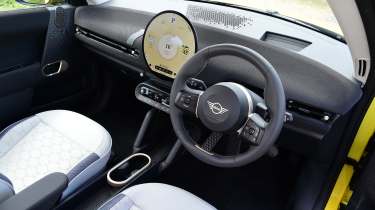
This being one of the larger cars on this list means there’s a decent amount of space for four passengers within the MINI Cooper, although the 200-litre boot is a bit stingy. There’s no arguing with the level of quality, though, as the materials and tech feel like they’ve been taken over from MINI’s parent company, BMW
“The electric MINI Cooper has enough agility about it to satisfy most customers. Approach a corner quickly, and the front end tucks in nicely; there’s excellent lateral grip and minimal body roll, so if you’ve enjoyed hugging the inside of a corner in your petrol-powered MINI over the years, you can do the same here.” - John McIlroy, former Auto Express editor-at-large
7. Suzuki Swift
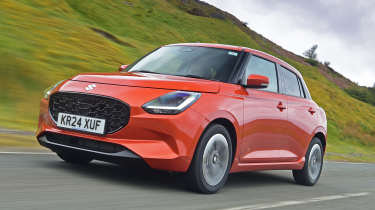
- Prices from £19,500
Pros |
Cons |
|
|
While the Suzuki Swift technically sits in the supermini sector, its efficiency and price are much more similar to those of a city car.
With only 81bhp and 112Nm of torque produced by the 1.2-litre engine, the latest Swift certainly isn’t the last word in performance. You can still have some fun behind the wheel thanks to its low kerb weight, although we had to work the powertrain quite hard to get the very best from it on our tests.
With mild-hybrid tech as standard, the Swift boasts very respectable efficiency. The front-wheel drive models can return over 60mpg on the WLTP combined cycle, while the four-wheel drive version (a rare option in this sector) isn’t far behind at around 57mpg.
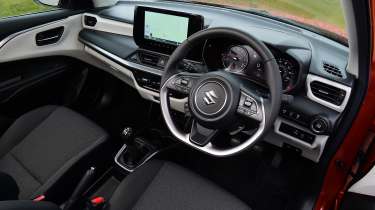
If there’s one area where the Swift fails to hide its low-budget ambitions, it’s the cabin. There’s a pretty generous helping of standard features, but low-rent materials can be found by the bucketload. At least the design is easy on the eye.
“In order to get the most out of this engine, carefully timed gear changes are required, so those who stick with the standard five-speed manual gearbox will get an arm and leg workout in hilly areas and while driving around town. Mercifully, the gearbox and clutch are forgiving to use, if a bit vague.” - Shane Wilkinson, senior content editor
8. Fiat 500e
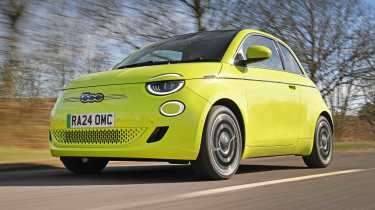
- Prices from £25,000
Pros |
Cons |
|
|
The Fiat 500e is exclusively available as an electric car, but there are still plenty of nods to this retro model’s heritage.
While it’s bigger than its predecessors both classic and modern, the latest 500 is still very compact by today’s standards. This relatively tiny stature combined with the retro design means there’s little mistaking it for any other car, but it also has a practical effect as it’s a breeze to navigate around narrow streets.
The battery tech is pretty good for a small EV, too. Opt for the larger 42kWh pack and the 500e can achieve up to 199 miles of range between charges. It can also be rapid-charged from 10 to 80 per cent in around half an hour.
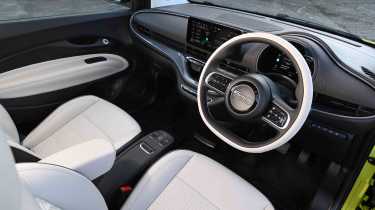
Take a peek inside and the 500e’s cabin continues the classic overall look. However, there’s more space inside than in previous 500s, and the on-board tech and materials have received a much-needed overhaul. Standard kit is generous, too, with alloy wheels, keyless entry, automatic wipers, cruise control and climate control all included.
“Being a city car, it’s at low speed where the 500e is designed to excel – and it does. Great visibility, tiny dimensions and a tight turning circle make everything from parking to darting in and out of traffic a doddle. Engaging your desired direction of travel is as simple as prodding one of the large buttons on the dash, and the power delivery is smooth and silent.” - Alex Ingram, chief reviewer
9. Toyota Aygo X
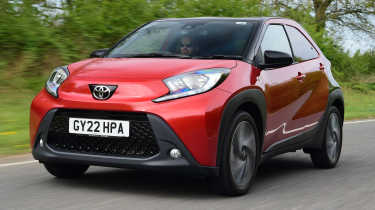
- Prices from £16,500
Pros |
Cons |
|
|
The Toyota Aygo X takes some of the best qualities of city cars and SUVs and manages to fuse them together.
After discontinuing the standard Aygo, Toyota revamped its pint-sized city car with a new crossover-style look, along with a number of upgrades both inside and out. The Toyota Aygo X sits higher, which allows for a better view of the road – one of the main advantages of a crossover – and it does a good job of soaking up bumps in the road for a slightly more civilised driving experience, too.
The Aygo X is pretty striking to look at but its roots in the previous Aygo are still evident. For now, the sole powertrain is a 1.0-litre three-cylinder petrol engine, which is nowhere near as eco-friendly as Toyota’s renowned hybrids. However, this engine does take things easy with its fuel consumption. When we tested the Aygo X against a Hyundai i10 in a group test, the Aygo X did manage a pretty respectable 51.9mpg.
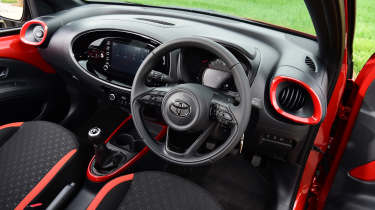
However, It’s noticeably roomier than the standard Aygo was in the front, and the extra length has also allowed Toyota to increase boot size to 231 litres. The interior is vibrant and manages to be fairly attractive, with flashes of colour and plastics that don’t feel overly cheap. Opt for the Edge or Exclusive trim and you can even have a folding canvas roof.
“There’s no denying the Aygo X feels light and agile, as a small city car should, and it’s quite fun to drive in the crowded areas it was designed for. We like the well-weighted steering which is light enough to make the car easy to park, but not light enough for it to feel nervous at higher speeds.” - Ellis Hyde, news reporter
10. Abarth 500e
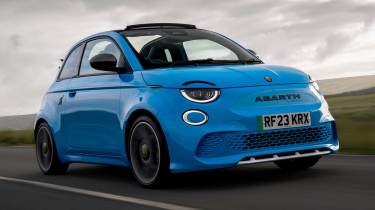
- Prices from £30,000
Pros |
Cons |
|
|
If you like the fashionable charm of the Fiat 500e but have something of a mischievous streak, the Abarth 500e will be the electric city car for you.
As well as offering much brighter paintwork than the regular Fiat 500e, the Abarth 500e is fitted with a more powerful 150bhp motor and an external speaker that attempts to replicate the pops, crackles and bangs of Abarth’s petrol-powered models. It’s not an outright performance machine like the Hyundai Ioniq 5 N or Alpine A290, but this is an amusingly unserious EV, provided you enjoy that sort of thing.
It certainly has plenty of character, but the Abarth 500e is still a city car at heart. There’s more than enough power to put a smile on your face between the traffic lights, but you’ll still have a claimed 164-mile battery range at your disposal. This certainly isn’t a groundbreaking range number, but the Abarth did return a real-world range of 157 miles after mixed driving during our testing so owners should be able to get very close to it.
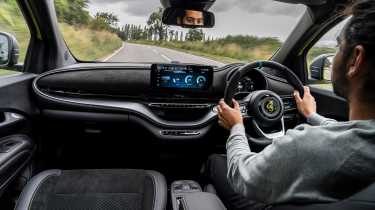
The Abarth 500e’s interior isn’t worlds apart from the one you’ll find in the Fiat 500e. It’s a pretty simple design, but you do get sportier seats and a generally high-quality feel.
“After turning the car on, the initial response is surprise – not at the sound itself, rather its quite unruly volume. Straight away, you can tell Abarth is not taking itself too seriously, a positive point despite the potential for teeth-grinding embarrassment, depending on the driver’s circumstances.” - Richard Ingram, deputy editor.
How we choose the best city cars
If you’re in the market for a new city car, here are some expert tips to take into account when building your shortlist and taking test drives.
Costs
It’s a very reasonable assumption that smaller cars should mean smaller costs, especially with an increasing number of fully electric city cars being introduced to the market. Our testers take the price range of every model into account, along with its real-world efficiency, applicable insurance groups, Vehicle Excise Duty rates and company car Benefit-in-Kind tax rates.
Practicality
City cars are small, but they’ve come a very long way from the compact models of the past. In today’s market, plenty of these cars offer an admirable helping of passenger and luggage space. Our expert road testers carefully measure head and leg room for every occupant, as well as the usable capacity and accessibility of the boot space.
If you’re considering a city car for family use, we also pay very close attention to how easy it is to fit a child seat, as well as the number of ISOFIX points
Driving
While outright performance might not be at the front of your mind when buying a city car, driving enjoyment and power output still play a role in determining what a car is like to live with.
A healthy dose of power will make pulling away from junctions and keeping up with traffic into much less of a chore, as well as making long-distance runs far easier. There’s no harm in enjoying your time behind the wheel, either, so a car that’s capable in corners and generally refined is all the better.
Try to take a test drive in an urban setting to get a feel for the all-round visibility in the car as well as the turning circle and the weight of the steering. If you’ll do most of your driving in town, a nippy, manoeuvrable feel makes all the difference.
Our expert road testers give every city car a thorough shake down on various types of road, ranging from the narrowest urban streets to massive motorways. The best cars are those that manage to blend comfort and refinement with performance and handling, which can be a difficult task for carmakers to achieve.
Best city car deals
Tell us which new car you’re interested in and get the very best offers from our network of over 5,500 UK dealers to compare. Let’s go…

